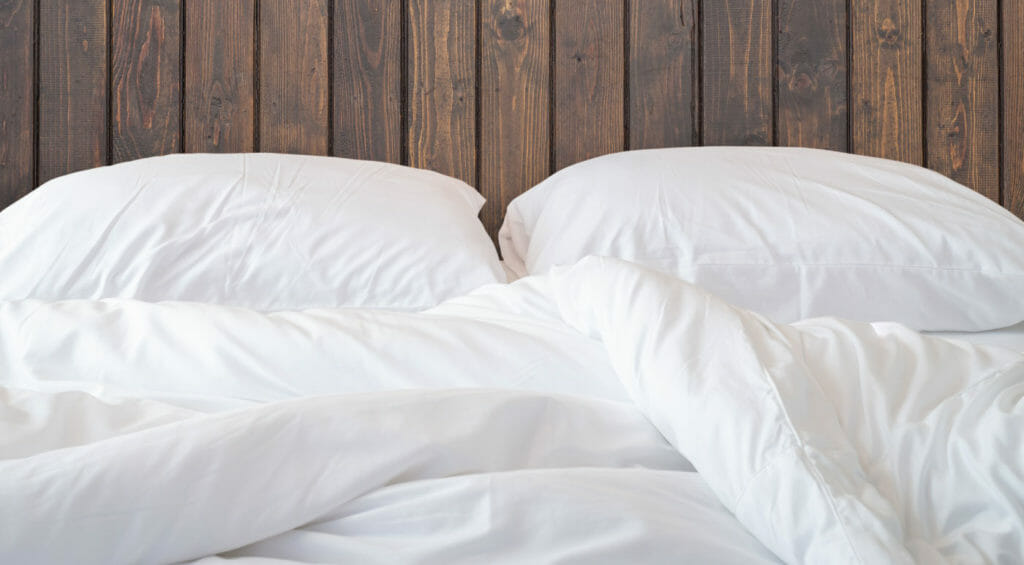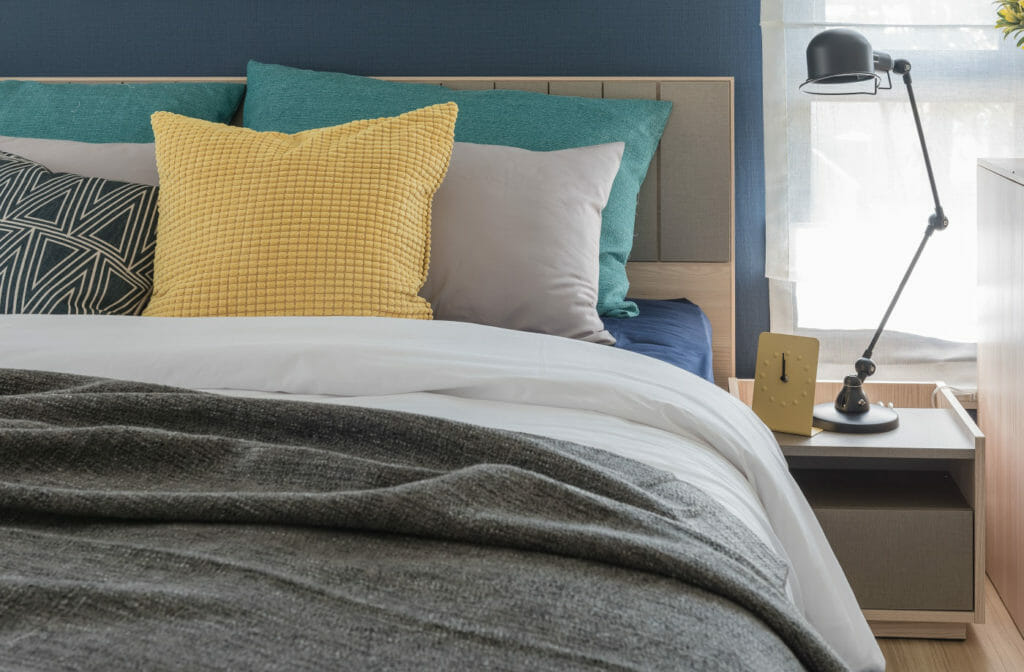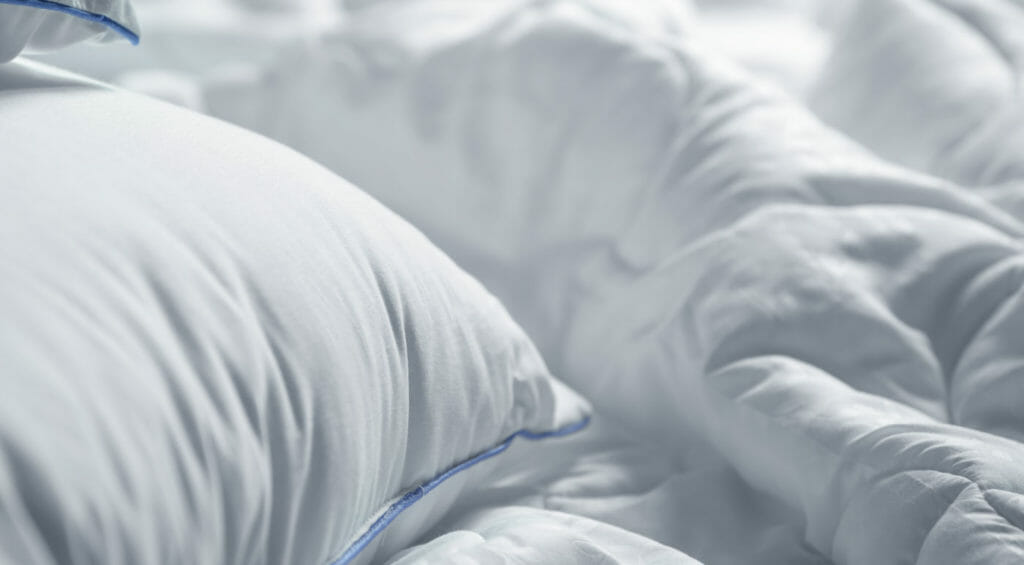
When purchasing bedding for your new mattress, you are faced with many options. One of those options includes whether to go with a comforter or a duvet. A duvet may sound like bedding owned exclusively by the elite, but the reality of this item is much more straightforward.
Many Americans confuse or don’t know the differences between a duvet and a comforter. There are several aspects to consider when choosing between a comforter and a duvet, including style, price, and material preferences.
What Exactly Is a Duvet?

The word “duvet” is derived from the French language, which may be what gives it such an airy sound when pronouncing the word. Duvet is French for down, which is a standard filling used for duvet bedding (“Definition of duvet,” 2019).
What distinguishes a duvet from a comforter or regular bedding is that a duvet is essentially a bag of stuffing. It requires a duvet cover, much like a pillow requires a pillowcase.
The materials used in the inner filling of a duvet are typically made with down or other ultra-soft fillings, characterizing the duvet as a super plush and soft bedcover (“Duvet,” 2018).
Fillings such as down and others used in duvets make this type of bedding thicker and often softer than comforters, although some comforters are just as soft and luxurious as duvets. The soft down frequently used in duvets is excellent at trapping heat, making this bedding great for cold winter nights.
Down is the very soft feathers that are located under the stiffer feathers of some types of waterfowl. In waterfowl, the down acts as an insulator that keeps the animal warm in cold temperatures (“Down feathers,” 2019).
Humans take advantage of the insulating properties of down by stuffing duvets and other bedding with this material. Individuals who suffer from allergies to feathers should avoid down duvets. Other duvet options, including cotton filled duvets, are available and may be a better option for allergy sufferers.
Advantages of Duvets vs. Comforters
Duvets offer several advantages over traditional comforters. One of the significant benefits is the ease with which duvets can be cleaned. Unlike comforters, duvets can be cleaned by removing and washing only the outer covering. In contrast, when attempting to clean a comforter the entire bedding has to be washed and dried, which can be a long process due to drying times. With it being so easy to do, the duvet cover is frequently washed as often sheets.
Keep in mind that many duvet inner bags can only be dry cleaned, while many comforters are machine washable. While the duvet needs cleaned less frequently when using a duvet cover, dry cleaning can be costly and a hassle. If the thought of having to occasionally send your duvet for dry cleaning causes you anxiety, make sure you purchase a duvet that can be machine washed.
Duvets eliminate the need for a top sheet, which is commonly used with comforters, since a duvet already has an outer covering that encases the duvet. For sleepers who feel claustrophobic at night or hate to be tangled in the sheets upon waking, a duvet is an excellent bedding option.
Another advantage associated with the use of duvets is the ease of switching styles of bedding, either seasonally or whenever the impulse arises. Comforters commonly have patterns or designs stitched or printed on the exterior. Most duvets are white, and you choose a duvet cover that is patterned or decorated. Since you cannot change the pattern on your comforters, the purchase of a comforter can be an expensive and long-term commitment to a specific style or color scheme throughout your bedroom. With a duvet, the process is made much easier by merely purchasing different duvet coverings. Changing duvet coverings can be a much more cost-effective option for those who like to change their bedroom decor frequently.
So What, Then, Is a Comforter?

Some individuals use the inner sack of a duvet as a comforter without a duvet cover. This ultimately defeats much of the purpose—and the advantages—of using a duvet. Using a duvet as a comforter occurs for a couple reasons. One may be ignorance of the advantages of using a duvet and duvet covering together—some people just don’t know! Another reason someone may use a duvet without a duvet cover is that they want the warmth of a duvet but don’t want the hassle of the maintenance of a duvet cover.
Comforters are generally not as thick as duvets, and many are filled with polyester. Polyester does not retain heat as efficiently as down, which means you may need to add an extra blanket on top of your comforter on chilly nights. The ability to add blankets on top gives comforters more versatility than duvets. If your climate and seasons vary between extremes of hot and cold, you may need to purchase several duvets with differing heat-retaining properties if you want to be comfortable year-round.
Selecting a Duvet
Selecting a quality duvet and duvet cover can save you both time and money over time, when it comes to cleaning this bedding. A quality duvet cover should include at least four loops on the inside of for securing the duvet itself. Without these inner loops, sleepers are prone to waking at night or in the morning with the duvet toward the bottom of the duvet covering.
Duvets come in all bed sizes, from twin to king size, so anyone interested in switching from a comforter to a duvet has options. Prices of duvets range from tens to hundreds of dollars, with the majority of duvets priced under a hundred dollars.
It’s important to make sure the duvet cover you purchase has buttons on the bottom—these are used to ensure that the duvet stays within the duvet covering throughout the night. A zippered closure is another option you may want to consider for closure at the bottom of the duvet cover. Zippered closures are handy for individuals who may not have the ability to use buttons efficiently and those who want a quicker way to put on and take off the duvet cover.
The type of duvet you select can depend on the season and the climate in which you live. Manufacturers of duvets rate their duvets on the degree of thermal insulating, which is called a “tog.” Togs can range up to 15. If summer is approaching or you live in a warmer climate, you would want to select a lower tog, typically under five.
The most common material used for duvet covers is cotton or cotton-polyester blend. Cotton and cotton-polyester duvet covers are machine washable and tend to feel softer over time. Bamboo duvet covers are available for those searching for an ultra soft and durable covering.
Which Should You Choose?

Choosing between a comforter and duvet is mostly a personal preference. Although there are many advantages to duvets, including ease of cleaning and the ability to frequently change your bedroom’s decor, the one disadvantage to duvets is that they are well insulated and may lead to overheating.
For people who tend to overheat during the night, a traditional comforter is likely the better option for a bed cover. Additionally, those with allergies to feathers may choose a comforter over a duvet, although there are duvets made with other fillings.
Additional Comparison Resources
California King vs. Standard King Bed
Mattress Pad vs. Mattress Topper
What Features Do Expensive Mattresses Have That Cheap Mattresses Do Not?